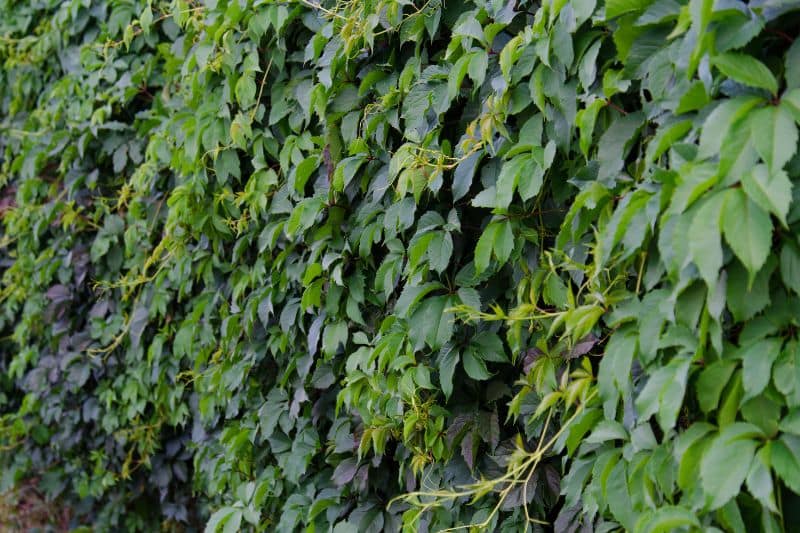What a magnificent sight a virgin vine ablaze with red and purple in autumn! Ideal to dress a façade or an unsightly wall, to provide shade under a pergola or arbor, virgin vine benefits from very rapid growth that can quickly make it invasive. Often associated with handsome period houses, virgin vine climbs, creeps and grips vertically thanks to its suction cups. These climbing plants from two different species, Parthenocissus and Ampelopsis, hide and cover an old tree trunk, an unattractive wire fence, an eyesore such as a tank or cistern... They also shelter abundant wildlife that forms a true ecosystem: lizards, insects, birds find shelter and food there. Virgin vine can also form a significant thermal barrier against heat!
However, it can be very expansive. Pruning is therefore necessary. Or even several prunings! Follow me: I explain when, how and why to prune virgin vine.
Why prune virgin vine?
Virgin vine absolutely does not need pruning to develop! Some varieties can even reach 10 to 15 metres in a few years, even 20 metres for the most vigorous. Needless to say, it very quickly colonises all surfaces that its suction cups can reach. Overall, the sarmentous shoots of virgin vine can develop 2 to 3 metres per season. Without much help (or almost none), since its suction cups, adhesive or non-adhesive, are enough to attach.
But there is a downside to this express growth! Virgin vine can become invasive. It clogs gutters and downpipes on houses, preventing rainwater from draining properly. Likewise, the voluble shoots of virgin vine can slip under roof tiles and lift them, causing leaks. Finally, its suction cups cling to shutters and blinds, and shoots can quickly obstruct windows without intervention.
Several attachment systems
The two species of virgin vine are differentiated by their attachment system :
- The various varieties of Parthenocissus quinquefolia and most Ampelopsis are equipped with tendrils, which means these virgin vines need a trellis or at least roughness to cling to. On a smooth wall, they do not attach
- Boston ivy (Parthenocissus tricuspidata) or Henry's virgin vine (Parthénocissus henryana) bear suction cups that allow them to scale a vertical surface unaided
- The Coignet vine (Vitis coignetiæ) has large leaves and simple tendrils and needs a support to climb.

Parthenocissus tricuspidata
When to prune virgin vine?
To limit virgin vine growth, two to three prunings per year are necessary:
- At the end of winter, late February to early March, because vegetation has not yet restarted and shoots are more apparent. Pruning will be easier and you will thus limit growth of this lovely climber
- In summer, between May and July, to maintain the branches
- Possibly, a final pruning in September to be left in peace over winter
How to prune virgin vine?
Tools to use
- A pruning shear
- A shear
- A pair of flexible gloves
- A ladder
- A bag or bin for garden waste
Cutting tools must be perfectly acute, and above all washed and disinfected with 90 °C alcohol to prevent spread of disease from one plant to another.
Structural and balancing pruning
This pruning is carried out in late winter during dormant period of virgin vine. As shoots are bare, intervention is easier. However, do not prune on a day of frost, rain or snow
- Begin at top of your façade and cut back with pruning shear shoots by 20 to 30 cm below roof and gutters and around windows and doors. Make sure to cut only lateral branches to preserve main framework. Take the opportunity to pull branches into free space so they will take a few weeks before fixing again on the vertical surface thanks to new suction cups
- Then, trim virgin vine foliage with the shear, keeping a thickness of 15 to 20 cm

Maintenance pruning
This pruning is done in summer, from May to July, when foliage is well developed. It allows thinning of that foliage, limiting its growth and vigour and controlling its spread. It is also an opportunity to remove dead or damaged branches.
Again, use the shear to make decisive cuts to the foliage.
This maintenance pruning can be repeated in September, to restore shape to the virgin vine. That way, you will be left in peace throughout winter.
These two prunings should not be carried out on very hot days.
To learn more :
- Virgin vine: planting, care, pruning
- Choosing a virgin vine: most beautiful varieties
































Comments